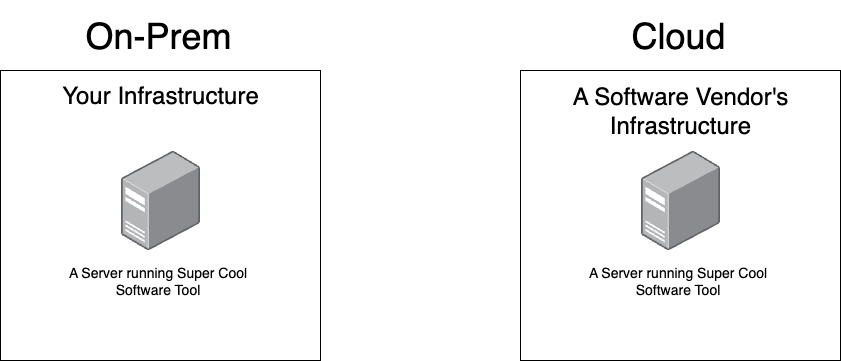From discussions with our customers and other folks in the higher education space, we have sensed that there has been some confusion regarding the differences in software that is hosted On-Premises (On-Prem) or in the Cloud. Part of the issue is that discourse has sometimes revolved around very specific features and not the general concepts of what is going on behind-the-scenes. Having knowledge of these behind-the-scenes concepts will assist in understanding the differences between On-Prem and Cloud software, and how SaaS fits into the picture.
First, a quick explanation of what “Cloud” actually is. Whenever I get asked by non-technical folks to explain what the “Cloud” is and how it’s different from hosting software On-Prem, I usually end up drawing a diagram that looks something like this:

You might be thinking: “That’s it? But what about the database, ERP, [insert other software here]?”. Yes, that’s it. Replace “Super Cool Software Tool” in the diagram with any software. Cloud just means that a software vendor is hosting the software instead of the customer.
Having someone else host software has huge implications for how the software is managed behind-the-scenes, and this is where the confusion usually begins. Having a software vendor host the software means that the vendor manages the infrastructure (servers, networking, security). Customers cannot make direct changes to the infrastructure for the software because they do not have access to the infrastructure. This is why Cloud hosted software does not allow customers to change core infrastructure like networking or web server certificates.
The other big implication for software hosted in the Cloud by a software vendor is that software updates and upgrades are handled by the vendor. This falls under infrastructure responsibilities because updating/upgrading software can also involve upgrading other components like the underlying operating system or network configuration. This requires direct access to the infrastructure, which only the software vendor has.
Software hosted in the Cloud means that the responsibility of managing the infrastructure is offloaded to the software vendor. Because of this, customers do not need to worry about managing anything related to the infrastructure. Software hosted On-Prem requires someone on the customer side to manage the infrastructure on their end. This is the main trade-off with hosting On-Prem vs Cloud.
SaaS (Software as a Service) is something that came along with most newly built software hosted in the Cloud. Most software vendors rent infrastructure from major Cloud providers like Amazon Web Services (AWS) or Microsoft Azure. The main advantage for software vendors to rent infrastructure is that they can scale up or down depending on demand for their software. This is why software hosted in the Cloud is billed on a subscription basis (this is what SaaS is).
I am also often asked: “Which is more cost efficient? On-Prem or Cloud/SaaS software?” Keeping in mind what I previously mentioned regarding who manages the infrastructure in both cases, it might become clearer now why the true cost of software will not only be the upfront or subscription costs. When hosting On-Prem, the infrastructure and management cost burden will be on the customer side. With Cloud/SaaS software, the infrastructure and management cost burden will be on the vendor’s side. Cloud/SaaS software has these costs built into the final subscription price of the software. So directly comparing the “one-time” cost of On-Prem vs the ongoing cost of Cloud/SaaS is not an apples-to-apples comparison (the On-Prem “one-time” cost does not factor in the ongoing infrastructure management costs on the customer side).
At the end of the day, the On-Prem vs Cloud/SaaS software discussions boil down to this key point: where the infrastructure for the software is hosted and who manages it. If your institution has in-house technical knowledge and capacity to manage software infrastructure, then On-Prem software might be a good fit. On the other hand, if your institution does not want to worry about hosting and managing another piece of software, then Cloud/SaaS software might be the better fit. Framing On-Prem and Cloud/Saas software purchasing decisions through this angle is the key to understanding which path is the best for your institution.


0 Comments
0 Comments